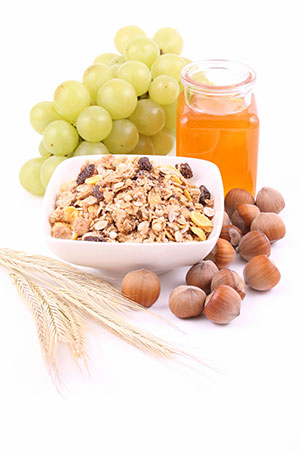Road To Wellness
General Health
People are becoming increasingly aware of the need to care for their own health through proper nutrition, exercise and rest. But along with this has also come a range of different diets claiming many health benefits. Be aware that some of them are quite extreme and may even be dangerous for your long-term health. Fortunately, there has been a constant basic message about healthy living that most nutritionists and health practitioners around the world support. This we will share with you.
These recommendations are the basics of a healthy lifestyle and are consequently suitable for everyone. If you do have a specific health condition such as diabetes, HIV or AIDS, heart conditions or if you are pregnant, go through this General Wellness information and then go to the section for your specific condition. The information under these specialised tabs will give you additional tips and information.

1. Nutrition
They say: ‘You are what you eat.’
Top of our list comes water – it is the basis of all the chemical reactions in your body, so try to drink 1.5 to 2.0 litres per day. That is just straight fresh water – not cool drinks or juices. Place a jug of water on your desk in the morning – having it right at hand will encourage you to drink it.
Secondly, eat your breakfast. Yes it is true; it is the most important meal of the day. It is best to eat breakfast within half an hour of getting up in the morning. The challenge will be choosing the right food. Sugar cereals are not the best, rather eat some oats porridge or wholewheat toast. Most important is that you add some protein. This can come in the form of eggs, kippers, haddock, or even cook an extra piece of chicken breast with your evening meal and have shredded chicken breast on toast for breakfast.
A breakfast that consists of a healthy carbohydrate and a protein will give you the energy you need, while it also serves to moderate the sugar levels in your blood. A good nutritious breakfast will also help your brain to function optimally, so it’s simply smart to eat breakfast.
Thirdly, eating small meals frequently is the best way to nourish your body. It seems to be a common practice in our busy lifestyles to skip breakfast, have a snack for lunch, and then eat a large supper. This is seen as a major contributor to many health problems. Eating frequent, small meals not only supplies the body with the nutrients that it needs but also regulates the blood sugar levels. This helps to ensure optimum energy levels.
Fourthly, the challenge is to ensure that you eat the right kinds of foods at these regular meals. Meals should include healthy carbohydrates and proteins, good fats and lots of non-starchy vegetables.
Carbohydrates: Healthy carbohydrates are the ones that release their energy slowly and are called low GI carbs. These include sweet potatoes, butternut, corn on the cob, barley, brown rice, low GI wholewheat bread, wholewheat pasta, and Ryevita or Provita. Remember fruit is actually packed full of carbohydrate energy and so, although they are healthy, they also need to be eaten in moderation. Fruit must be considered as a carbohydrate portion. So if you want to have an apple with your lunch then you can leave out any other carbohydrates. A good choice of a fruit carbohydrate is the one that releases its energy slowly. These include apples, pears, citrus, melons, berries and plumbs.
Contrary to what the advertisers say, eating sugar simply does not give you sustained energy, rather it is a high GI carb that leads to unhealthy blood sugar level spikes. Avoid high GI carbs such as white and brown sugar, sweets, chocolates, jam, biscuits and cookies. Also avoid any baked foods made with white or brown flour, vetkoek, mielie pap, white and brown bread, potatoes, refined sweet breakfast cereals, sugary fizzy drinks and fruit juices.
Protein: Healthy proteins you can include in each meal include any fish (fresh or canned in brine), eggs, chicken breast (without the skin), red meat (with the fat carefully removed before cooking). Try to have red meat no more than three times per week. Good protein also includes all legumes like lentils, dried beans and chickpeas.
If you are trying to lose weight and you are using legumes as your main protein source, do be aware that legumes are not pure protein, rather they are a combination of carbohydrate and protein. You want to try and ensure that you are getting enough protein and not over eating carbohydrates. You could increase the legume portion to slightly more than a fist size and reduce your carbohydrate portion to slightly less than a fist size.
Vegetables: A group of foods that are so important for our health but that many people do not seem to eat enough of are the non-starchy vegetables. These include broccoli, green beans, cauliflower, patty pans, baby marrows, cabbage, fresh asparagus, kale, tomatoes, peppers and cucumber.
Portion sizes: When making up your plate of food ensure that half the plate is made up of non-starchy vegetables. That will be the size of two to three fists of non-starchy vegetables, one fist size of carbohydrate and one portion of protein. The protein portion ideally is the size of the palm of your hand and the thickness of a pack of playing cards.
Good fats: Fat has been given a bad name over the years and been blamed for all sorts of ailments. The truth is that only part of this blame is valid. In the health industry fats have been grouped as the good, the bad, and the ugly. So it is only the bad and ugly fats that are to blame for poor health. Bad fats are the fats that are found in animal products such as red meat, butter, full cream milk, yogurt and ice cream. Ugly fats are the trans-fats they have been chemically changed to increase a product’s shelf life and found in cookies and biscuits and brick margarine. The good fats are essential for many body functions, including the functioning of the nervous system and brain. These good fats are also needed for many hormones to function correctly. Good fats are obtained from olive oil, olives, avocado, oily fish, and nuts. A fair portion size would be the size of 2 fingers. Women should eat about three portions per day and men five portions per day.
So often our intentions to eat well are not successful, simply because we do not have the good food at hand and we find ourselves hungry and snacking on crisps and chocolate bars. This is why planning is an essential element, as you start to develop healthy eating habits. This all starts with drawing up meal plans and then a shopping list based on the food in your plan. Some blank meal plans are supplied under the Healthy Eating section. Plan, plan, plan – plan for success!
2. Exercise
Finding the will and opportunity to exercise seems to be a challenge for many people. The lack of exercise is increasingly identified as a contributing factor to many lifestyle diseases. Finding a way to exercise on a regular basis is essential for good health.
Cardio vascular: This form of exercise includes running, swimming, dancing and cycling. The objective is to increase your heart rate and the flow of blood around the body, to improve overall health by helping to control blood pressure, blood sugar, blood lipids, and stress.
There is some consensus that for the body to remain healthy, a person needs to do cardio vascular exercise and break a sweat, for 20 minutes at least three time per week.
Resistance: Resistance training, like lifting weights, builds muscle and not only gives a person a beautiful shape but also enhances the metabolism. A biokineticist would be able to assist you in choosing the best kind of exercise for you and a fitness coach would be able to guide you in carrying out an exercise programme correctly.
Core: Many healthy people also choose to do specific exercises that strengthen their core muscles – like the abdominals and lower back. A strong core is supportive of your back and helps to develop a good posture. Exercises like Pilates and yoga are good for this.
If you do not have a personal trainer or biokineticist, follow a basic exercise programme that you can do at home, where the exercises can be done in a small space and no equipment is needed. Whatever exercise you do it’s vital that you stay motivated and keep yourself on track.
3. Rest
With our modern, stressed lifestyles we need to ensure that we have sufficient rest. Your body and mind are not only resting but also rebuilding during the sleeping hours. Try your best to get 7 – 8 hours of uninterrupted sleep per night. Remember alcohol does not help you sleep better – it actually reduces the quality of your sleep and impedes your necessary recovery. Rather create a calm and quiet space before going to bed – like reading something relaxing.
4. Mindset and attitude
Scientific studies clearly show the powerful effect of our mindset and attitudes on physical wellness. Find a practice like meditation, yoga, or other mindfulness techniques to reduce your stress and calm you. Worship and prayer is also a powerful tool for finding peace.
Finally, if you find that these recommendations are very different from your current lifestyle and you consider adopting them, it would be wise to consult your health practitioner and ask for their support and guidance as you start changing your lifestyle.
Sources:
http://www.sparkpeople.com/resource/nutrition_articles.asp?id=1144
https://www.nhlbi.nih.gov/
http://www.ichangeforhealth.co.za/
http://www.webmd.com/diet/ss/slideshow-healthy-fat-foods
http://www.nhs.uk/livewell/healthy-eating/Pages/Healthyeating.aspx


